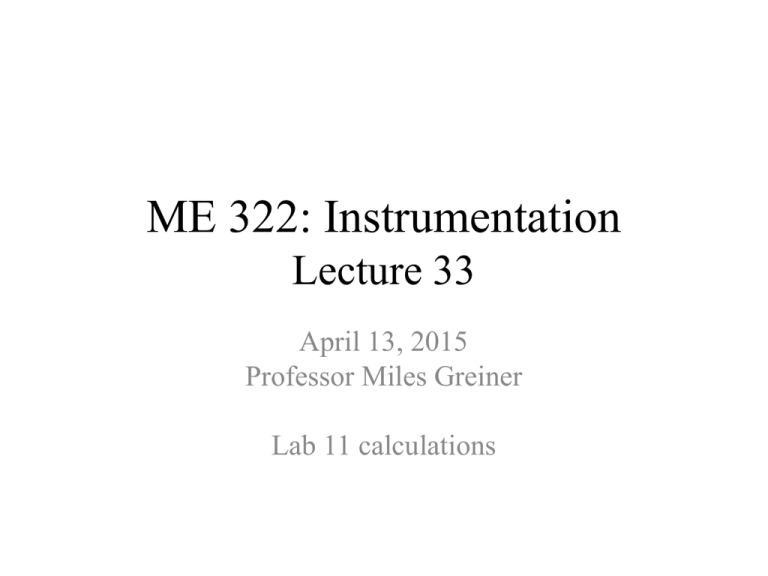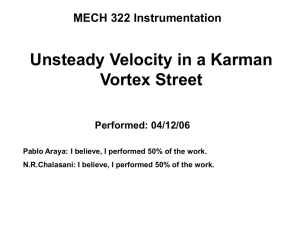
ME 322: Instrumentation
Lecture 33
April 13, 2015
Professor Miles Greiner
Lab 11 calculations
Announcements/Reminders
• HW 10 due now
• On Friday I announced the delay
• HW 11 due Friday
• This week: Lab 10 Vibrating Beam
• Sign up for 1.5-hour Lab 11 periods with your partner in lab
• This is one of the labs that you could be asked to repeat on the
final
• Help wanted
– Spring 2016: ME 322 Lab Assistant
– see me greiner@unr.edu
Lab 11 Unsteady
Speed in a Karman
Vortex Street
• Nomenclature
– U = air speed (instead of V)
– VCTA = Voltage output of constant temperature anemometer (CTA)
• Two steps
– Statically calibrate hot film CTA using a Pitot probe
– Find frequency, fP with largest URMS downstream from a cylinder of diameter D
for a range of air speeds U (Measured with no rod, Why?)
• Compare to expectations (StD = DfP /U = 0.2-0.21)
Setup
myDAQ
Variable Speed
Blower
VCTA
Plexiglas
Tube
Barometer
PATM
TATM
CTA
DTube
Cylinder
Pitot-Static
Probe VC
Static
Total
+
3 in WC
• Same as Lab 6 but add CTA and
cylinder, and do not use Venturi tube
or Gage Pressure Transducer
• Tunnel Air Density
–𝜌=
𝑃𝐴𝑇𝑀 +𝑃𝐺𝑎𝑔𝑒
𝑅𝐴𝑖𝑟 𝑇𝐴𝑇𝑀
= 𝑐𝑜𝑛𝑠𝑡𝑎𝑛𝑡
PP IP
Before Experiment
• Construct VI (formula block)
• Measure PATM, TATM, and cylinder D
• Find m and r for air
T
D
P
m
r
N-s/m2 Kg/m3
Kelvin inch kPa
296.2 0.125 88.1 1.8262E-05 1.037
• Air Viscosity from A.J. Wheeler and A. R. Ganji, Introduction to
Engineering Experimentation, 2nd Edition, Pearson Prentice Hall,
2004, p. 430.
Fig. 2 VI Block Diagram
Spectral Measurements
Selected Measurements: Magnitude (RMS)
View Phase: Wrapped and in Radians
Windowing: Hanning
Averaging: None
Formula
Formula: ((v**2-b)/a)**2
Fig. 1 VI Front Panel
Calibrate CTA
using Pitot Probe
• Remove Cylinder
Pitot
Probe
Hot Film
Probe
– So air speed is relatively steady
• Align hot film and Pitot probes
– So both are exposed to same air speed
– Careful, hot film probes cost $150 each
Cylinder
• Based on physical analysis (last lecture) we expect
2
– 𝑉𝐶𝑇𝐴
=𝑎
𝑈 +𝑏
• For different blower speeds (and outlet covering) measure
– VCTA (use myDAQ, average voltage using fS ~ 48,000 Hz, tS ~ 1 sec)
– IP (Pitot probe, DMM, “eyeball” average)
– In Lab 11 use 8-12 wind speed
• including blower off
• In Final used fewer if time is an issue
Calibration Calculations
IP
[mA]
2𝑃𝑃
𝜌𝐴𝑖𝑟
• 𝑈𝐴 = 𝐶
– 𝜌𝑊 =
UA1/2
VCTA UA
[V] [m/s] [m1/2/s1/2] [V2]
=𝐶
2𝜌𝑊 𝑔𝐹𝑆
𝐼𝑃 −4𝑚𝐴
16𝑚𝐴
𝜌𝐴𝑖𝑟
𝑘𝑔
998.7 3
𝑚
– 𝐹𝑆 = (3 𝑖𝑛𝑐ℎ 𝑊𝐶)
– 𝜌𝐴𝑖𝑟 =
VCTA2
𝑃𝐴𝑇𝑀
𝑅𝐴𝑖𝑟 𝑇𝐴𝑇𝑀
2.54 𝑐𝑚
𝑖𝑛𝑐ℎ
1𝑚
100 𝑐𝑚
Hot Film System Calibration
IP
[mA]
4.00
5.70
7.40
9.40
11.60
16.80
14.40
13.30
11.00
8.50
6.30
4.00
VCTA
[V]
2.140
3.670
3.930
4.070
4.130
4.460
4.340
4.290
4.160
4.000
3.820
2.140
UA1/2
UA
[m/s] [m1/2/s1/2]
0.0
0.00
12.4
3.52
17.5
4.18
22.0
4.70
26.2
5.11
33.9
5.83
30.6
5.53
28.9
5.38
25.1
5.01
20.1
4.49
14.4
3.79
0.0
0.00
VCTA2
[V2]
4.58
13.47
15.44
16.56
17.06
19.89
18.84
18.40
17.31
16.00
14.59
4.58
• The fit equation VCTA2 = aU1/2 +b appears to be appropriate for these data.
• Using least squares the best values for the dimensional parameters are
– a = 2.643 volts2s1/2/m1/2
– b = 4.5742 volts2
Standard Error of the Estimate
𝑆
2
𝑉𝐴 ,𝑉𝐶𝑇𝐴
x
VCTA2
x
x
x
x
x
x
x
𝑆𝑉 2
𝐶𝑇𝐴 ,
𝑉𝐴
𝑈
• Find coefficients of best fit line, a and b
–
2
𝑉𝐶𝑇𝐴,𝑓𝑖𝑡
=𝑎
UA1/2
𝑈 +𝑏
• Find Standard Error of the Estimate
– 𝑠𝑦,𝑥 = 𝑠𝑉 2
𝐶𝑇𝐴 ,
𝑈
=
VCTA2 di2=(aVA1/2+b-VCTA2)2
[m /s ] [V2]
[V4]
0.00
4.58
0.00
3.52
13.47
0.01
4.18
15.44
0.02
4.70
16.56
0.00
5.11
17.06
0.39
5.83
19.89
0.15
5.53
18.84
0.01
5.38
18.40
0.00
5.01
17.31
0.01
4.49
16.00
0.01
3.79
14.59
0.09
0.00
4.58
0.00
1/2
𝑎
𝑈 𝑖 +𝑏 −
𝑛−2
2
𝑉𝐶𝑇𝐴
𝑖
2
1/2
0.26
0.10
Measure VCTA to determine 𝑈 and 𝑤𝑈
• Invert transfer function
2
– 𝑉𝐶𝑇𝐴
=𝑎
𝑈 +𝑏
2
𝑉𝐶𝑇𝐴
−𝑏
𝑎
– 𝑈=
2
(use this function in VI)
• Uncertainty
– 𝑠
2
𝑈,𝑉𝐶𝑇𝐴
=
𝑠 𝑉2
𝐶𝑇𝐴 , 𝑈
𝑎
• uncertainty in
=𝑤
𝑈
(68%)
𝑈 is independent of U
• But we want the uncertainty in U, 𝑤𝑈 (not uncertainty in 𝑈)
– 𝑈=
–
𝑈
𝑤𝑈 2
𝑈
=
2
Power Product?
𝑤 𝑈 2
2
𝑈
– But 𝑤
–
𝑤𝑈
𝑈
=
2
(68%)
𝑈 = 𝑠 𝑈,𝑉𝐶𝑇𝐴
𝑠 𝑈,𝑉2
𝐶𝑇𝐴
2
(68%)
𝑈
– 𝑤𝑈 = 2
𝑈
𝑠
2
𝑈,𝑉𝐶𝑇𝐴
(68%)
• uncertainty in U increases with U
Unsteady Speed Downstream from a Cylinder
6
Without Cylinder
5
Hot Film
Speed, s [m/s]
UA
4
3
With Cylinder
2
1
0
0
0.002
0.004
0.006
0.008
time, t [sec]
0.01
• Enter values of a and b in VI
• For each measurement use fS ~ 48,000 Hz, sampling time tT ~ 1 sec
• For each blower speed
– Remove cylinder to measure average speed approaching cylinder UA
– Return cylinder and measure unsteady speed
• Determine frequency fP with highest URMS
– Eyeball
– Uncertainty in fP is larger of
» Frequency resolution: ½(1/tT) ~ 1/2 Hz, or
» Eyeball range
• Repeat for ~5 different blower speeds
Fig. 2 VI Block Diagram
Spectral Measurements
Selected Measurements: Magnitude (RMS)
View Phase: Wrapped and in Radians
Windowing: Hanning
Averaging: None
Formula
Formula: ((v**2-b)/a)**2
Fig. 4 Spectral Content in Wake for Highest and Lowest Wind Speed
(a) Lowest Speed
Srms [m/s]
0.4
0.3
fp = 751 Hz
0.2
0.1
0
0
500
1000
2000
2500
3000
f [Hz]
0.5
Srms [m/s]
1500
0.4
(b) Highest Speed
0.3
fp = 2600 Hz
0.2
0.1
0
0
•
•
•
•
500
1000
1500
2000
2500
3000
f [Hz]
The sampling frequency and period are fS = 48,000 Hz and tT = 1 sec.
The minimum and maximum detectable finite frequencies are 1 and 24,000 Hz.
The frequency resolution is ½ (1/tT) = ½ hz
However, the shape of the peaks are somewhat broad, leading to 𝑤𝑓𝑃 ~ 50 𝐻𝑧
Dimensionless Frequency and Uncertainty
UA [m/s] WUa [m/s]
37.8
1.3
34.1
1.2
27.3
1.1
23.0
1.0
16.5
0.8
11.8
0.7
fP [Hz] wfp [Hz]
2600
50
2427
50
1892
50
1596
50
1218
50
751
50
Re
7084
6385
5121
4312
3081
2214
WRe
236
224
201
184
156
132
• UA from LabVIEW VI
• 𝑤𝑈 = 2
𝑈
𝑠
2
𝑈,𝑉𝐶𝑇𝐴
• fP from LabVIEW VI plot
• 𝑤𝑓𝑃 = ½(1/tT) or eyeball uncertainty
• Re = UADr/m (power product)
–
𝑤𝑅𝑒 2
𝑅𝑒
=
𝑤𝑈𝐴 2
𝑈𝐴
+
𝑤𝐷 2
𝐷
+
𝑤𝜌 2
𝜌
+
• StD = DfP/UA (power product)
–
𝑤𝑆𝑡 2
𝑆𝑡
= −
𝑤𝑈𝐴 2
𝑈𝐴
+
𝑤𝐷 2
𝐷
+
𝑤𝑓 𝑃 2
𝑓𝑃
𝑤𝜇 2
𝜇
St
0.218
0.226
0.220
0.220
0.235
0.202
WSt
0.008
0.009
0.010
0.012
0.015
0.018
Comparison with Expectations
• Are the values you get for St within the expected
range?
Demo
• Construct VI
– Formula Block
– Convert to Dynamic Data
• Perform calculations using sample data from
Lab 11 webpage
– http://wolfweb.unr.edu/homepage/greiner/teaching/MECH322Instrume
ntation/Labs/Lab%2011%20Karmon%20Vortex/Lab%20Index.htm





